Cycloramphus cedrensis is a species of frog in the family Cycloramphidae. It is endemic to southern Brazil and is only known from its type locality near Rio dos Cedros, Santa Catarina. Common name Cedros button frog has been coined for it.
Cycloramphus duseni is a species of frog in the family Cycloramphidae. It is endemic to southern Brazil and only known from its type series collected in 1911 from near Casa Ypiranga along the Curitiba–Paranaguá railway, in the Serra do Mar, Paraná state. Prior to naming of Cycloramphus izecksohni in 1983, it was confused with this species. The specific name duseni honors Per Dusén, Swedish naturalist who collected the type series. Common name Ypiranga button frog has been coined for this species.

Cycloramphus eleutherodactylus is a species of frog in the family Cycloramphidae. It is endemic to the Serra do Mar in southeastern Brazil, including the Serra dos Órgãos, Serra da Mantiqueira, and Serra da Bocaina. Common name Alto button frog has been coined for it.
Cycloramphus izecksohni is a species of frog in the family Cycloramphidae. It is endemic to southern Brazil and occurs in the Serra do Mar in the states of Santa Catarina, Paraná, and São Paulo. Prior to its description in 1983, it was confused with Cycloramphus duseni. Common name Izecksohn's button frog has been coined for this species.

Cycloramphus stejnegeri is a species of frog in the family Cycloramphidae. It is endemic to the Serra dos Órgãos in southeastern Brazil. The specific name stejnegeri honors Leonhard Stejneger, a Norwegian–American herpetologist and ornithologist. Common name Stejneger's button frog has been coined for this species.
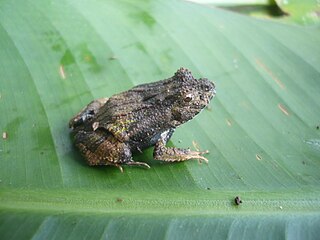
Edalorhina perezi is a species of frog in the family Leptodactylidae. It is one of the only two species in the genus Edalorhina in the family Leptodactylidae. This species is diurnal and terrestrial. During mating season both female and male frogs gather around treefall pools. It is found in Brazil, Colombia, Ecuador, and Peru, and possibly Bolivia. Its natural habitats are subtropical or tropical moist lowland forests, subtropical or tropical moist montane forests, and freshwater marshes. The species listed as least concern on the IUCN Red List and the population is stable.
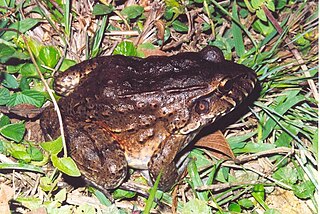
Leptodactylus labyrinthicus is a species of frog in the family Leptodactylidae. Its common names are labyrinth frog, pepper frog, South American pepper frog, and pepper foam frog. This frog is found in central and southeastern Brazil, northeast Argentina, and eastern Paraguay. Earlier reports from Bolivia refer to Leptodactylus vastus, or possibly an unnamed species.
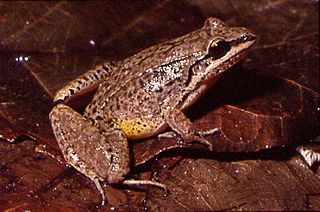
Leptodactylus notoaktites is a species of frog in the family Leptodactylidae. It is endemic to southeastern Brazil and is known from the states of Santa Catarina, Paraná, and São Paulo state. Common name Iporanga white-lipped frog has been coined for it.
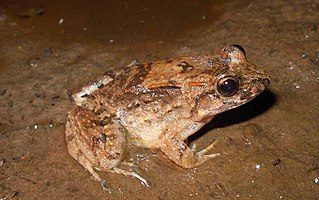
Leptodactylus petersii is a species of frog in the family Leptodactylidae. It is found widely in the Guianas and the Amazon Basin. It has been confused with Leptodactylus podicipinus and Leptodactylus wagneri, complicating the interpretation of older records and accounts.

Leptodactylus podicipinus, sometimes known as the pointedbelly frog, is a species of frog in the family Leptodactylidae. It is found in northern Argentina, Paraguay, Uruguay, Bolivia, and Brazil.

Leptodactylus syphax is a species of frog in the family Leptodactylidae. It is found in extreme eastern Bolivia, central to northeastern Brazil, and Paraguay. Common names basin white-lipped frog and whistling foam frog have been coined for it.
Megaelosia goeldii, also known as the Rio big-tooth frog, is a species of frog in the family Hylodidae. It is the only member of the genus Megaelosia. It is endemic to Southeast Brazil and occurs in São Paulo and Rio de Janeiro states. It is named after Émil Goeldi, a Swiss zoologist who worked in Brazil.
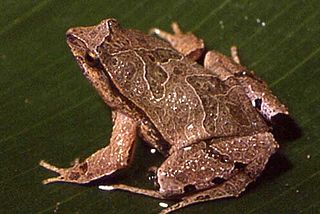
Physalaemus maculiventris is a species of frog in the family Leptodactylidae. It is endemic to Southeast and South Brazil and is known primarily from the Serra do Mar in Espírito Santo, Rio de Janeiro, São Paulo state, Paraná, and Santa Catarina states. Common name Mantagnes dwarf frog has been proposed for it.

Physalaemus moreirae is a species of frog in the family Leptodactylidae. It is endemic to the Serra do Mar in the São Paulo state, Brazil.
Proceratophrys concavitympanum is a species of frog in the family Odontophrynidae. It is endemic to Brazil and known from Rondônia, northwestern Mato Grosso, Pará, and Tocantins. It is the only Proceratophrys found in the Amazon rainforest.

Thoropa is a genus of frogs in the family Cycloramphidae. They are endemic to eastern and southeastern Brazil. They are sometimes known as river frogs.
Thoropa saxatilis is a species of frog in the family Cycloramphidae. It is endemic to southern Brazil and occurs in the Santa Catarina and Rio Grande do Sul states, corresponding to the southernmost extent of the Atlantic Forest biome. The specific name saxatilis refers to its association with rocks. Common name Brazilian river frog has been coined for it.

Leptodactylus discodactylus is a species of frog in the family Leptodactylidae. It is found in the Amazonian Bolivia, Brazil, Peru, Ecuador, and Colombia.

Petropedetes cameronensis, sometimes known as the Cameroon water frog, is a species of frog in the family Petropedetidae. It is found in southeastern Nigeria, southwestern Cameroon, and on the island of Bioko. It is the type species of the genus Petropedetes.

Brachycephalus nodoterga, also known as the Serra Cantareira saddleback toad, is a species of frog in the family Brachycephalidae. It is endemic to the eastern São Paulo state of southeastern Brazil, and only known from five locations in Atlantic rainforest at altitudes of 700–900 m (2,300–3,000 ft).














